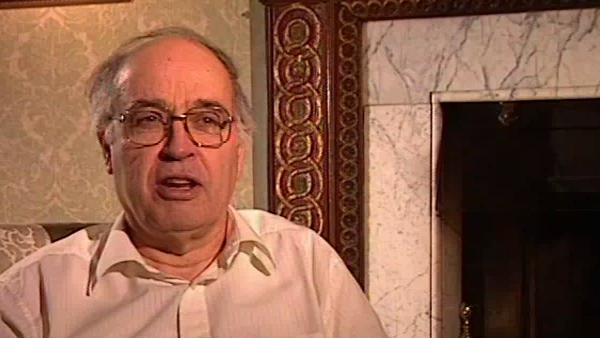NEXT STORY

Euclidian version of twistor theory
RELATED STORIES

NEXT STORY

Euclidian version of twistor theory
RELATED STORIES


|
Views | Duration | |
|---|---|---|---|
| 61. Lacunas and hyperbolic equations | 551 | 04:01 | |
| 62. Further research on lacunas | 443 | 02:36 | |
| 63. Instanton | 1 | 628 | 03:25 |
| 64. Evolving story of instantons | 528 | 02:38 | |
| 65. Almost beaten by Manin | 929 | 01:31 | |
| 66. Euclidian version of twistor theory | 636 | 02:08 | |
| 67. Collaborating with physicists | 1239 | 02:08 | |
| 68. The lack of a background in physics | 1 | 1229 | 02:02 |
| 69. Three manifold invariants | 790 | 02:55 | |
| 70. Individual contributions | 675 | 01:02 |


It was really one of these sort of rather dramatic instances, wasn't it, because we'd... we’d spent the morning working on this thing. And I... I suppose we'd been working at it before, getting… using Horrock’s construction. We'd finally got the solution; we saw how it all fitted together, and as usual what happens when... when you found… discover you've solved a problem; you... you stop for lunch. You know, on the grounds that it might turn out to be wrong and you... you enjoy your lunch while thinking you've solved the problem.
I've done this very often. Sometimes you come back and its right; sometimes you come back it's wrong. Anyway, we stopped for lunch, and then we came back after lunch and there was this letter from Manin saying he'd solved the problem too, and spelling out exactly what he was doing. I mean it was, in a way, a bit... bit off-putting to find that. On the other hand, his... his approach… although they... they… I suppose at that stage they were a little ahead of us… because he'd got as far as sending me the details which he'd written in the proof, and we'd discovered it that morning. So I suppose in strict chronological order, they'd... they’d done it first.
On the other hand, it wasn't totally independent because after my paper with Richard Ward, when we started on this problem, he'd heard about this one and got interested, and he'd written to me. And I'd... I’d told him about the Horrock’s constructions as an interesting possibility to, you know… a way of going forward. So obviously he'd taken it up with Drinfeld. They'd come back, got it, and so the message was coming back. So it was a sort of… in some sense a indirect kind of collaboration at a distance. But it was rather a dramatic… if we'd… one, one day later we'd... we’d have been beaten to it completely.
Eminent British mathematician Sir Michael Atiyah (1929-2019) broke new ground in geometry and topology with his proof of the Atiyah-Singer Index Theorem in the 1960s. This proof led to new branches of mathematics being developed, including those needed to understand emerging theories like supergravity and string theory.
Title: Almost beaten by Manin
Listeners: Nigel Hitchin
Professor Nigel Hitchin, FRS, is the Rouse Ball Professor of Mathematics and Fellow of Gonville and Caius College, Cambridge, since 1994, and was appointed to the Savilian Professorship of Geometry in October 1997. He was made a Fellow of the Royal Society in 1991 and from 1994 until 1996 was President of the London Mathematical Society.
His research interests are in differential and algebraic geometry and its relationship with the equations of mathematical physics. He is particularly known for his work on instantons, magnetic monopoles, and integrable systems. In addition to numerous articles in academic journals, he has published "Monopoles, Minimal Surfaces and Algebraic Curves" (Presses de l'Universite de Montreal, 1987) and "The Geometry and Dynamics of Magnetic Monopoles" (Princeton University Press, 1988, with Michael Atiyah).
Tags: Richard Ward, Geoffrey Horrock
Duration: 1 minute, 32 seconds
Date story recorded: March 1997
Date story went live: 24 January 2008